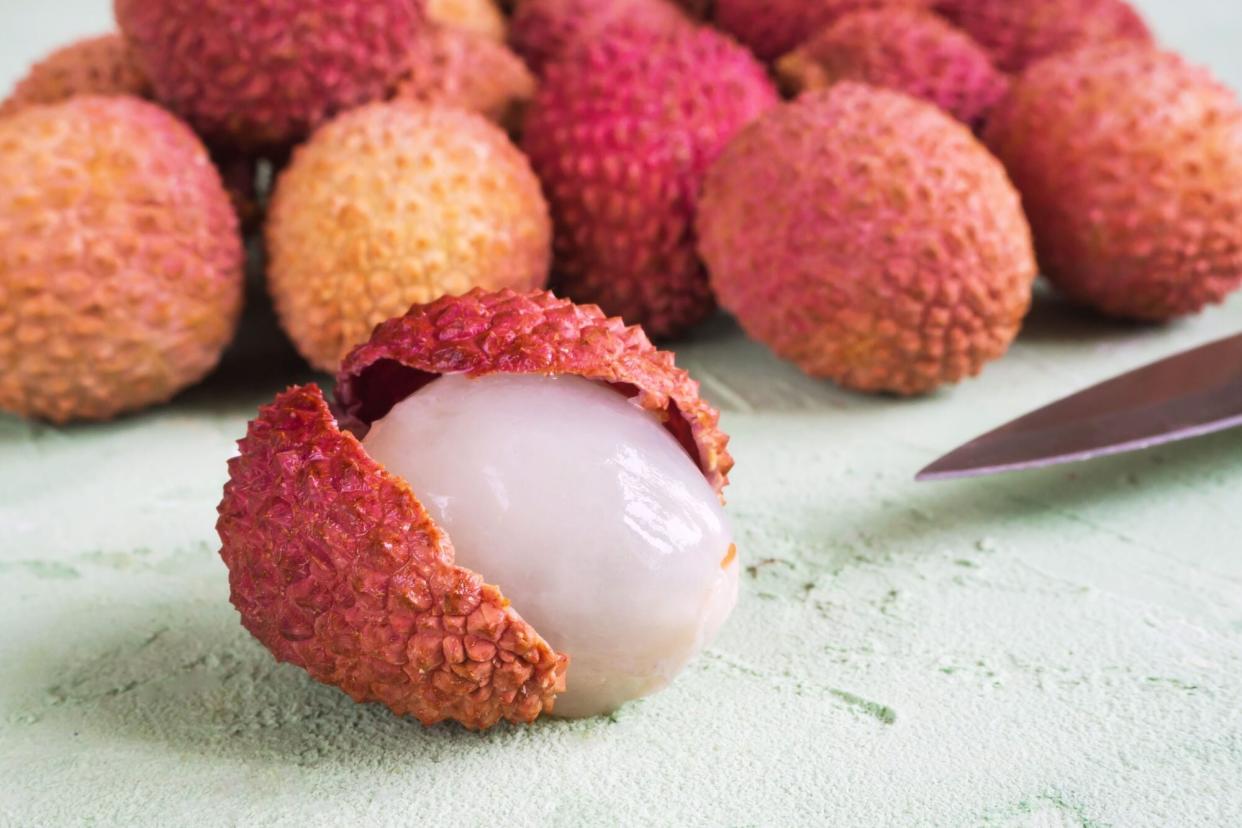Your Guide to Lychee: How to Peel and Enjoy This Juicy, Diminutive Fruit

Stanislav Sablin / Getty Images
If you're a fan of fresh and floral flavors, you'll want to add lychee to your rotation. The juicy fruit is wonderfully aromatic, making it a lovely addition to sweet and savory recipes alike. However, in order to reach its fragrant flesh, you'll need to remove the leathery skin first. Ahead, learn how to peel lychee and our favorite ways to enjoy the fruit at home.
Related: Everything You Need to Know About Yuzu
What Is a Lychee?
Lychee, or litchi, is a tropical fruit native to Southern China. It's part of the soapberry family, which includes other tropical eats like rambutan and longan. Lychee is also a drupe, or stone fruit, which means its structure is similar to produce like peaches or cherries. It consists of one large, dark brown seed that's inedible and unsafe to eat. This seed is encased in a transparent white flesh, which is the only edible part of the fruit. (The flesh feels like firm jelly, similar to the texture of peeled grapes.) Finally, the flesh is surrounded by a hard, bumpy peel, which is also inedible. The peel might be red, pink, or purple red, depending on the type of lychee you have. In the United States, the most common variety that's sold in stores typically boasts a pinkish-red peel. You can usually find lychees at specialty Asian markets, where they're available fresh and whole (unpeeled) or canned (peeled) in syrup. Some big-box grocery stores may sell the canned version, too.
How to Peel Lychees
If you're lucky enough to find fresh lychees, you'll be glad to know that peeling them requires no special equipment. "Although the skin feels brittle and tough, it should give from [the pressure of] your thumbnail," explains Cynthia Chen McTernan, founder of Two Red Bowls and author of A Common Table: 80 Recipes and Stories from My Shared Cultures: A Cookbook ($29.40, amazon.com). In other words, you can peel lychee by hand, just like you would an orange. Simply puncture the skin with your thumbnail, then peel it away. This will expose the pearly white flesh. From there, slice the flesh along the side to expose the seed. Using your fingers, separate the flesh and seed, then discard the latter. The inside of the flesh will likely be lined with a thin, brown layer leftover from the seed; this part is edible, says McTernan, so it's recommended to leave it. Besides, it doesn't come off as easily as the peel, she adds, so it's best to go ahead and eat it.
Though peeling lychees doesn't require special tools, you might want do it over a bowl. As McTernan notes, lychees are very juicy, so peeling the fruits can get messy. Fortunately, any juices that end up in the bowl can be repurposed in a myriad of recipes.
How to Use Them at Home
Lychees are sweet and slightly acidic fruits. The flavor is often described as fresh, floral, and aromatic—similar to pear or watermelon, according to some people. That being said, lychees pair well with tropical and floral ingredients, such as rose. McTernan also suggests pairing the fruit with similar delicate flavors (like white peach), as well as tart ingredients, like raspberries.
If you're still looking for inspiration, McTernan recommends using lychee just as you would any fruit. For example, you can eat it as is or add it to desserts, including baked goods. McTernan particularly enjoys using lychees like pineapples or peaches in recipes such as cobbler or upside-down cake. It can also serve as a filling for mochi or snow skin mooncakes, or chewy rice cakes that are traditionally eaten in Asia, she adds. If you're looking for a no-bake option, try tossing chopped lychees into your next fruit salad or batch of homemade ice pops. As a garnish, lychee can effortlessly sweeten up dishes like smoothie bowls, yogurt, and ice cream. Meanwhile, in the beverage department, the fragrant fruit can will steal the show. Both fresh and canned lychees are right at home in tropical cocktails, iced teas, or sangrias, like this rose sangria with nectarines and strawberries. The juices and flesh can also be used to brighten up plain water, seltzer, or coconut water. Or, for an icy concoction, blend lychees into a tropical smoothie with ingredients like frozen pineapple, mangoes, and oranges.
You might be surprised to learn that lychees can be used in savory dishes as well. McTernan points to ceviche, a South American dish made with raw fish and citrus juices. "The texture of lychee would work well with raw fish or as a plant-based alternative [for it]," shares McTernan. "You could also use it in fried rice as an alternative to pineapple, [as well as] in glazes for chicken or fish," she adds.

